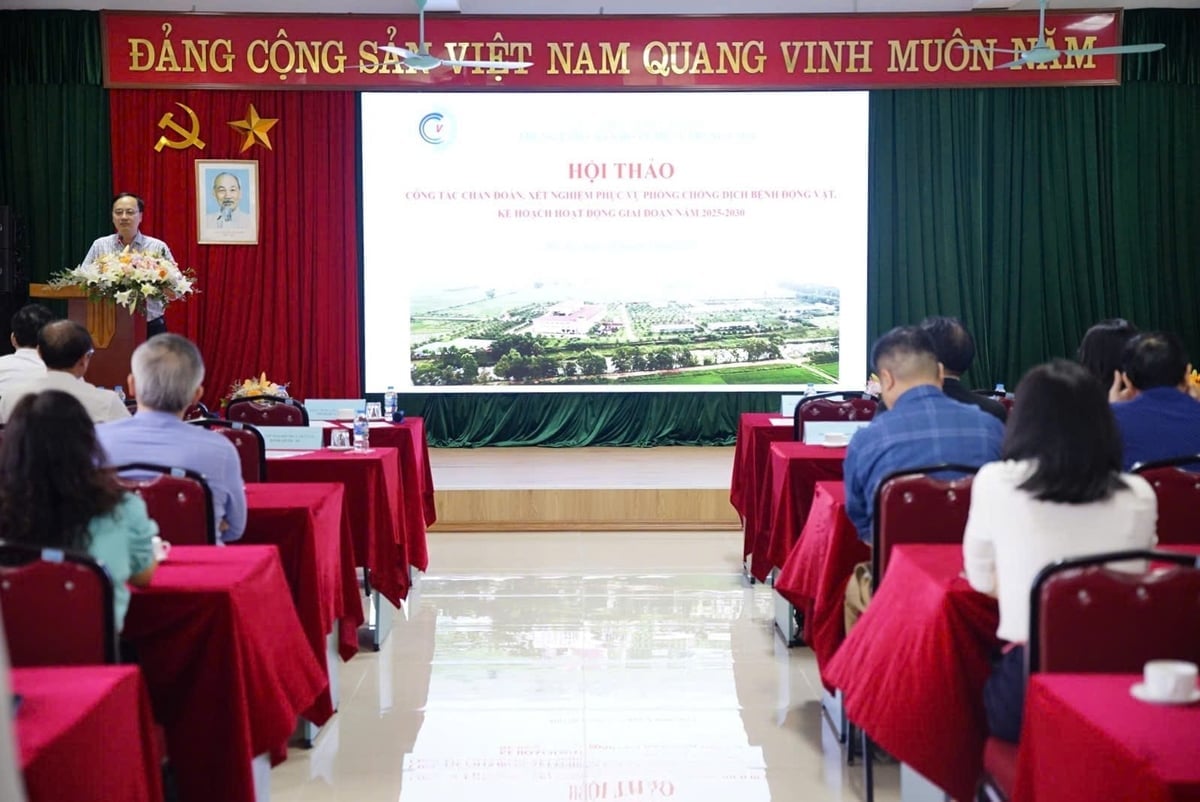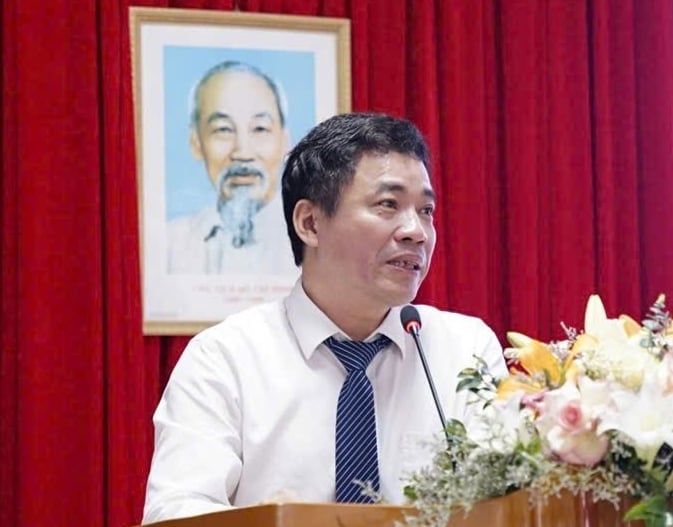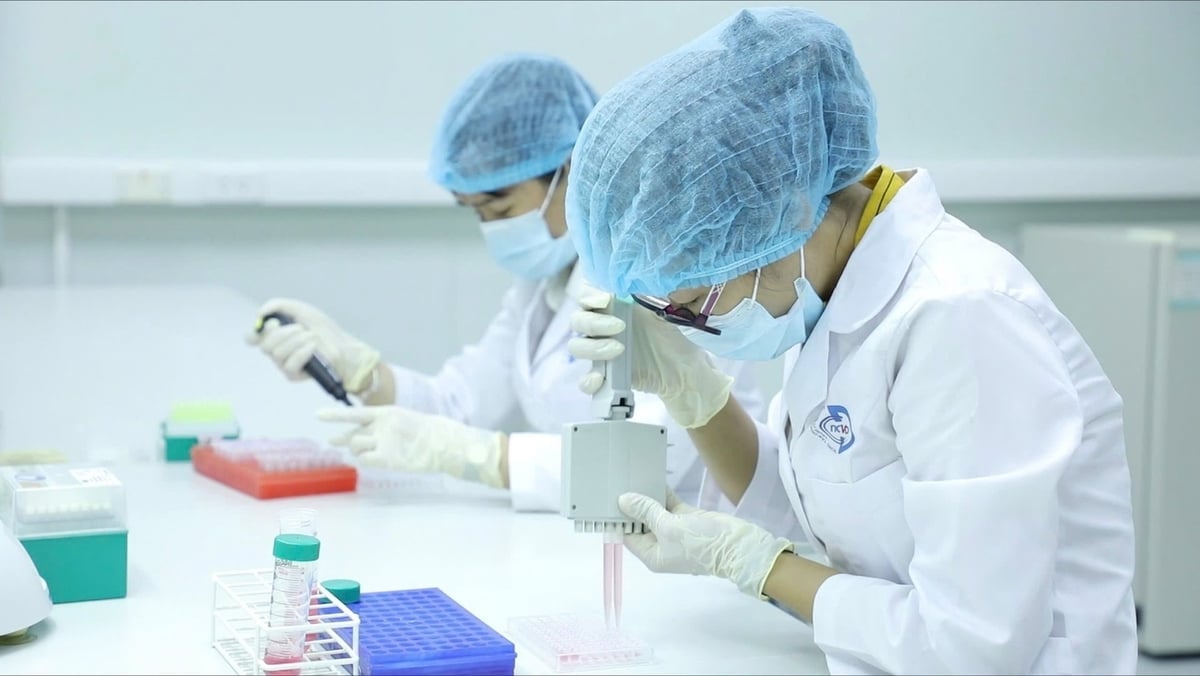December 21, 2025 | 20:45 GMT +7
December 21, 2025 | 20:45 GMT +7
Hotline: 0913.378.918
December 21, 2025 | 20:45 GMT +7
Hotline: 0913.378.918
On April 18, the centre, which meets to Biosafety Level III laboratory standards, presented its operational plan for the 2025–2030 period and conducted a workshop that concentrated on diagnostic and testing initiatives for the prevention and control of animal diseases.

Workshop on diagnosis and testing for animal disease prevention; action plan for the period 2025-2030. Photo: Linh Linh.
Mr. Ngo Van Bac, Acting Director of the Central Veterinary Diagnosis Centre, underscored the importance of diagnostic testing in the context of Vietnam's livestock industry's transition to large-scale, biosecure, environmentally sustainable agricultural models during his presentation at the workshop.
A report on the Center's activities from 2019 to 2024 and its strategy for 2025 to 2030 indicates that the centre has received substantial investment in both infrastructure and human resources. It currently maintains laboratories that are certified at Biosafety Levels 2 and 3, an ABSL3 animal testing facility, a clean animal housing area, and modern apparatus that can process 1,500 to 5,000 samples per day.
Furthermore, the centre is being supplemented by specialized facilities that are scheduled for completion by October 2025 as part of a Korean-funded aid project. This project will improve the testing capabilities for large livestock.

Mr. Ngo Van Bac, Acting Director of the Central Veterinary Diagnostic Center, shared at the Workshop. Photo: Linh Linh.
The centre has analyzed 568,746 disease samples in the last six years. Swine diseases comprised the largest proportion (66.76%), followed by poultry (21%), cattle (4.1%), and aquatic animals (5.2%) in that order. It has promptly identified and responded to emerging diseases, including African Swine Fever (ASF), Lumpy Skin Disease (LSD), H5N8 avian influenza, and Bovine Viral Diarrhea (BVD).
In addition to diagnostics, the centre sequences the genomes of hazardous virus strains, identifying recombinant variants of H5N1 in tigers and leopards in Đồng Nai and Long An. The sector has been able to make timely decisions regarding the appropriate use of vaccines as a result of these findings.
The centre also conducts efficacy trials of various veterinary vaccines during both the development and post-marketing phases. This includes the effective implementation of numerous research projects and disease surveillance programs, such as the monitoring of PRRS virus, ASF, and SARS-CoV-2 in wildlife.
It intends to enhance surveillance of significant animal diseases, including H5N1, H5N6, ASF, PRRS, and foot-and-mouth disease, in the 2025–2030 timeframe. Its objective is to expedite the sequencing of pathogen genomes using cutting-edge technologies, such as Nanopore, and to broaden the diagnostic capabilities for zoonotic diseases.
The centre has also suggested that management authorities include new provisions in the Veterinary Law to more effectively regulate biosafety and biosecurity in the context of high-risk infectious agents in diagnostic testing, disease research, vaccine development, and biological production. It advocated for greater transparency and stricter oversight of test data from private entities, as well as enhanced personnel policies, to guarantee the diagnostic system's long-term effectiveness and stability.
Dr. Phan Quang Minh, the Deputy Director of the Department of Livestock Production and Animal Health, emphasized the critical role of diagnostics and testing in the advancement of the livestock sector, which is anticipated to expand by 5.7% to 5.92% in 2025.
He observed that the successful management of diseases is contingent upon the precise identification of pathogens. He cited an instance from 2020–2021 in which the Central Veterinary Diagnosis Centre had proactively collected samples and identified Lumpy Skin Disease in Lang Son prior to its official registration in Vietnam. This exemplified the center's high sense of responsibility and expertise.

Vietnam's testing capacity is now up to standard, but it still needs to expand testing capacity to face new threats. Photo: Linh Linh.
The department emphasized the necessity of enhancing Vietnam's testing capabilities to address both known and emergent threats, despite the fact that they currently meet international standards.
Mr. Pawin Padungtod, Senior Coordinator of the FAO's Emergency Centre for Transboundary Animal Diseases (ECTAD), reiterated FAO's commitment to supporting Vietnam in the application of digital technology for the surveillance and management of animal diseases.
He expressed his admiration for Vietnam's implementation of an online disease reporting system, which enables the efficient administration of data and the timely dissemination of epidemiological information. The early detection of emerging diseases and the strengthening of outbreak surveillance and control are both facilitated by the integration of test results into this system.
The FAO representative also underscored the significance of incorporating new technologies into disease management and diagnostics. Vietnam's technical personnel will continue to receive training and capacity-building support from the FAO to ensure that their practices are consistent with international standards.
Translated by Linh Linh

(VAN) The 2025 Joint Response Plan (JRP) identifies three core priorities and calls for $96.2 million to support disaster recovery for 1.4 million people.

(VAN) Risk assessment methodology enables early risk identification, rational resource allocation, and the development of control measures tailored to the food value chain.

(VAN) Once considered a waste product to be burned, rice straw in the Mekong Delta is now being collected and processed through mechanization and biotechnology, paving the way for a sustainable circular agricultural model.

(VAN) Risk assessment in food safety management not only helps protect public health but also promotes sustainable development.

(VAN) Prime Minister chaired the 26th meeting of the National Steering Committee on Illegal, Unreported, and Unregulated (IUU) Fishing.

(VAN) Cuba is currently streamlining procedures to attract investors, with many new policies shaped by the practical experiences of Vietnamese projects operating in the country.

(VAN) Patrol Team No. 15 has been executing patrol, inspection, and control duties in the Southwest waters, a region identified as having a high risk of violations.